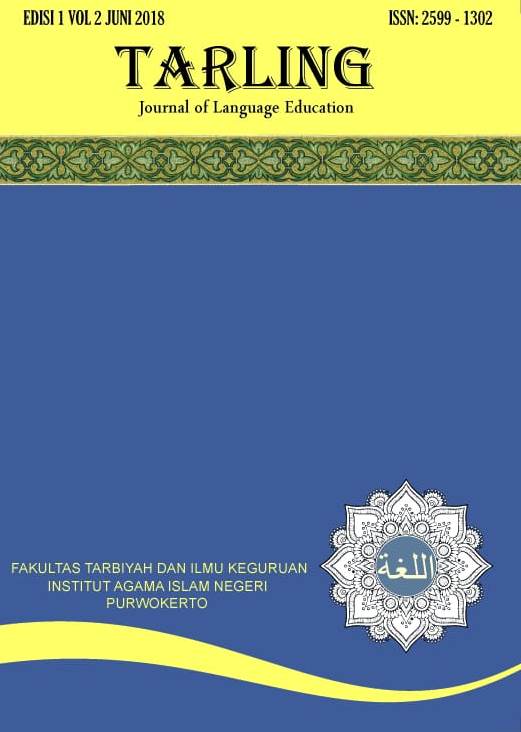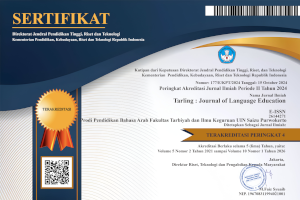النحت المعاصر واستفادته في تنمية اكتساب مفردات اللغة العربية لطلاب المدرسة العالية بإندونيسيا
DOI:
https://doi.org/10.24090/tarling.v6i1.6346Kata Kunci:
Sculpture, Vocabulary Acquisition, High SchoolAbstrak
النحت كلمة مشهورة الذي لم يعرف كثير من الطلاب بالمدراس العالية بإندونيسيا ولكن قد استخدم به العربيون في بعض الأحيان وكما استخدم الإندونيسيون أيضا في الاتصال في هذا العصر الحديث. هذا البحث مهمّ لمعرفة النحت على وجه العام ومعرفة النحت المعاصر في اللغة العربية، واقتراح محاولات المعلم على استفادة النحت المعاصر في تنمية اكتساب المفردات لطلاب المدرسة العالية بإندونيسيا. هذا البحث النوعي استخدم المنهج الوصفي مستعينا بالكتب والمقالات العلمية والوسائل المكتبية الأخرى. ونتائج البحث: 1) معرفة مفهوم النحت على وجه العام 2) مفهوم النحث المعاصر، 3) الاقتراحات للمعلم على استفادة النحت المعاصر في تنمية اكتساب المفردات لطلاب المدرسة العالية بإندونيسيا هي ثلاثة: (1) يعد المعلم الكراسات التدريبات التي تتضمن فيها المفردات الجديدة من النحت المعاصر زيادة إضافة مصاحبة لكتب المواد التعليمية الأساسية المقررة؛ (2) يتيح المعلم الطلاب الفرصة لمتابعة برنامج اللغة العربية في تلفيزيون وشبكة الإنترنت لبحث المصطلحات الجديدة من النحت المعاصر؛ (3) يتيح المعلم الطلاب الفرصة لشاهدة سينيما العرب معا عند عملية التعليم.Unduhan
Diterbitkan
2022-06-30
Terbitan
Bagian
Articles
Lisensi
Hak Cipta (c) 2022 Sugeng Ali Mansur

Artikel ini berlisensiCreative Commons Attribution-ShareAlike 4.0 International License.
Authors who publish with this journal agree to the following terms:
- Authors retain copyright and grant the journal right of first publication with the work simultaneously licensed under a Creative Commons Attribution License that allows others to share the work with an acknowledgement of the work's authorship and initial publication in this journal.
- Authors are able to enter into separate, additional contractual arrangements for the non-exclusive distribution of the journal's published version of the work (e.g., post it to an institutional repository or publish it in a book), with an acknowledgement of its initial publication in this journal.
- Authors are permitted and encouraged to post their work online (e.g., in institutional repositories or on their website) prior to and during the submission process, as it can lead to productive exchanges, as well as earlier and greater citation of published work (See The Effect of Open Access).










